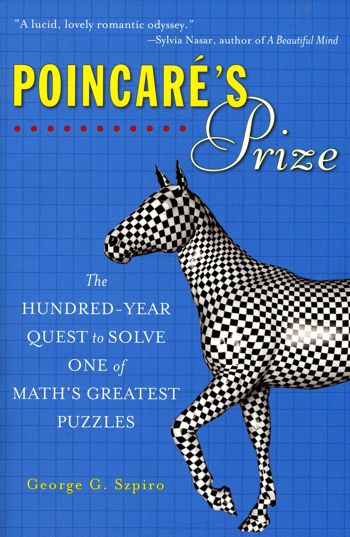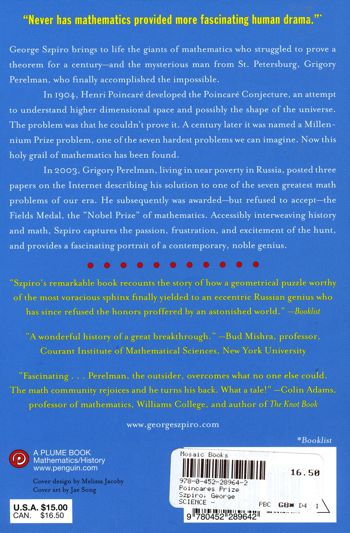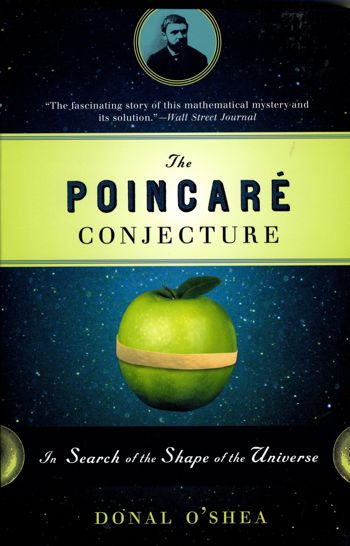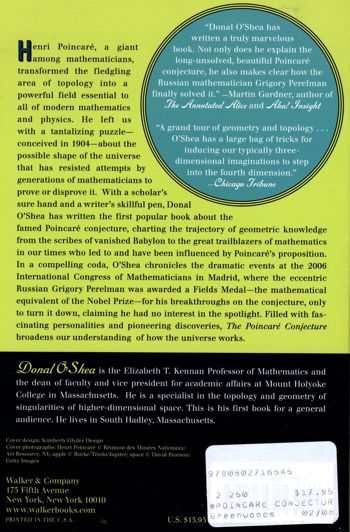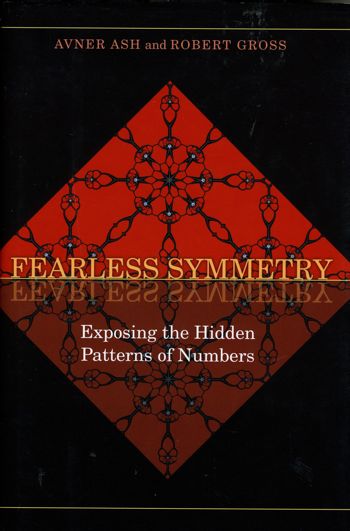Wednesday December 31, 2008 5:30 am Lethbridge
It is -10 C with a high forecast of -1 C. Sunrise 8:29 Sunset 16:41 Hours of daylight: 8:12.
See current Lethbridge forecast here. See current Lethbridge news here.
This page last updated on:
Thursday, January 1, 2009 8:01 AM
A. Morning Musings
I have just realized that I have a second book that describes the same problem as the Szpiro book. I will add it to my list of activities and read both books at, more or less, the same time. One of the nice features of the O'Shea book is the inclusion of a few figures, which makes a lot of sense when the topic is topology, often described as the mathematics of shapes.
The topic is fascinating for at least three reasons. One is that both books provide a history of topology, a branch of mathematics that in many senses first began to take shape with Poincare's work. Two, the conjecture that Poincare made about figures in topology had generalizations to describing the shape of the universe, a pretty impressive application. Third, the mathematician who finally provided a proof of Poincare's conjecture in 2003, is a Russian mathematician, Grisha Perelman, who has shunned the both the Fields Medal (equivalent to a Nobel Prize in mathematics) for his work as well as the Clay Prize for solving one of the "Millenium" problems, which just happens to be worth a million dollars. The difficulty for both authors is to provide a sense of the mathematics for the general reader while noting that this is a problem that had eluded the world's best mathematicians for over a century.
| Learning Category |
Planned Activities for Today |
Time |
| Mathematics |
Continue reading "Poincare's Prize" by George Szpiro |
1 hr |
| Mathematics |
Begin reading "The Poincare Conjecture" by Donal O'Shea |
1 hr |
| Mathematics |
Continue "Fearless Symmetry" by Ash & Gross |
1 hr |
B. Actual Learning Activities
7:00 am
The O'Shea book provides a number of sources and links that allow one to see (but not to understand) the original Perelman papers. Locating web sources as well as recently published books is a fascinating exercise in its own right. The book by Tian & Morgan, indicated as forthcoming by O'Shea, is now available at amazon.com. The title is "Ricci Flow and the Poincare Conjecture" (2007) and one can read the first few pages on the amazon web site. This is not for the faint hearted.
While on the amazon.com web site I happened to notice some scathing reviews of mathematics books by a Scott Guthrie, including one on Fearless Symmetry. I like his basic point about the difference between mathematics books and books about mathematics. He actually gives a slightly positive review of the O'Shea book, which is the only positive review I noted by him.
I am glad I came across Guthrie's reviews. It is not so much a matter of agreeing or disagreeing with him, as the degree to which his reviews made me think. Not only is there a game of Bourbaki being played (this is an inside metaphor) but there is the incredibly difficult issue of how does one move from A to B when there is such a wide range of possible backgrounds among the potential readers and learners.
Is the only approach to find a substantive textbook and begin at page one? Or look at the MIT open courseware web site? Some books do not pretend to teach any real mathematics but do want to give the reader a sense of what all the excitement is about. The two books that I have on the Poincare conjecture definitely fall in this category.
Not withstanding his critique on Fearless Symmetry, which I must admit I agree with, I think I will still continue to read it. I think it provides a useful preliminary introduction to many of the ideas in abstract algebra. But it is also clear that this is all it does. If I am really serious about trying to understand the basic ideas of group theory and how they apply to an understanding of symmetry, then I will need to adopt a more rigorous approach to the topic. There are no short cuts. I keep coming back to two books. One is the book by Goodman that is available on the web:
http://www.math.uiowa.edu/~goodman/algebrabook.dir/algebrabook.html
The other is a book I bought at the MIT Bookstore when I was in Boston in the early 1980's: Stevens, P. S. (1980). Handbook of Regular Patterns: An Introduction to Symmetry in Two Dimensions.
http://www.amazon.com/Handbook-Regular-Patterns-Introduction-Dimensions/dp/0262690888
8:00 am
A great beginning to the day. The light is just beginning to come on, both outside and inside. I will shift my immediate reading to the O'Shea book, and continue my reading of Fearless Symmetry. Upon completion of these two books, I will set up a reading program based on the twin threads of Goodman and Stevens. C'est tout!
Books on the Go Today |
|
|
|
|
|
see below |

Next Page

